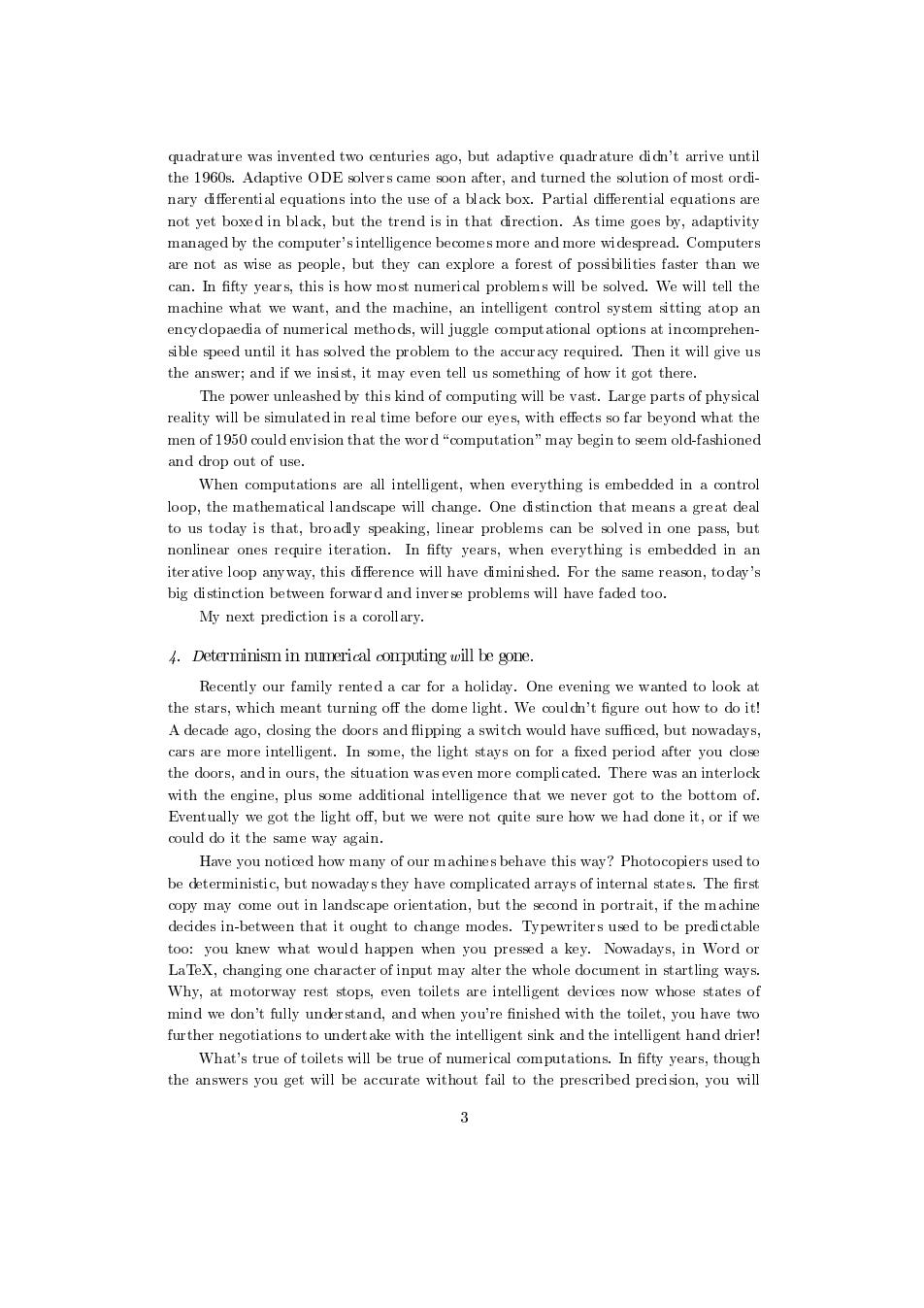正在加载图片...

quadrature was invented two centuries ago,but adaptive quadrature didn't arrive unti the 1960s.Adaptive ODE olvers came soon after,and turned the solution of most ordi nary dfferential equations into the use of a black box.Partial differential equations ar not yet boxed in black,but the trend is in that drection.As time goes by,adaptivity managed by the computer'sintelligence becomesmore and more widespread.Computers are not as wise as people,but they can explore a forest of possibilities faster than we can.In fifty years,this is how most numerical problems will be solved. We will tell th machine what we want,and the machine,an intelligent control system ing atop ar e comput ationa olved the problen the will give us the answe even tel by this kind of computing will e parts reality simulated in me b ore our eyes,witl o far beyo what th men of 1950c mav begin to seem old-fashioned ,when everything is embedded in loop,the mathematical landscape will change.One dstinctio nat means near prob ved mn In fift d or eason,today' My next prediction is a corollary. 4.Determinism in mumerical computing will be gone. Recently our family rented a car for a holiday.One evening we wanted to look at the stars,which meant turning off the dome light We couldn't figure out how to do it A decade ago,dosing the doors and flipping a switch would have sufficed,but nowadays ars are more intelligent n some,the light stays on for a fixed aft you tion waseven more Ther e was an interlo 时thth ngine, ditional intelligence that we never Dottom o ff,but we were not quite sure how we had doneit,or if we any of our m achin ve this way?Photo opiers used t ays they nave d array opy ma ld han Why don't fully under ou're finis I with the toile further nege t hand drier true of toilets will be In fift the te without fail to the bed prquadrature was invented two centuries ago, but adaptive quadrature didn't arrive until the 1960s. Adaptive ODE solvers came soon after, and turned the solution of most ordinary di
erential equations into the use of a black box. Partial di
erential equations are not yet boxed in black, but the trend is in that direction. As time goes by, adaptivity managed by the computer's intelligence becomes more and more widespread. Computers are not as wise as people, but they can explore a forest of possibilities faster than we can. In
fty years, this is how most numerical problems will be solved. We will tell the machine what we want, and the machine, an intelligent control system sitting atop an encyclopaedia of numerical methods, will juggle computational options at incomprehensible speed until it has solved the problem to the accuracy required. Then it will give us the answer; and if we insist, it may even tell us something of how it got there. The power unleashed by this kind of computing will be vast. Large parts of physical reality will be simulated in real time before our eyes, with e
ects so far beyond what the men of 1950 could envision that the word \computation" may begin to seem old-fashioned and drop out of use. When computations are all intelligent, when everything is embedded in a control loop, the mathematical landscape will change. One distinction that means a great deal to us today is that, broadly speaking, linear problems can be solved in one pass, but nonlinear ones require iteration. In
fty years, when everything is embedded in an iterative loop anyway, this di
erence will have diminished. For the same reason, today's big distinction between forward and inverse problems will have faded too. My next prediction is a corollary. 4. Determinism in numerical computing wil l be gone. Recently our family rented a car for a holiday. One evening we wanted to look at the stars, which meant turning o
the dome light. We couldn't
gure out how to do it! A decade ago, closing the doors and ipping a switch would have suced, but nowadays, cars are more intelligent. In some, the light stays on for a
xed period after you close the doors, and in ours, the situation was even more complicated. There was an interlock with the engine, plus some additional intelligence that we never got to the bottom of. Eventually we got the light o
, but we were not quite sure how we had done it, or if we could do it the same way again. Have you noticed how many of our machines behave this way? Photocopiers used to be deterministic, but nowadays they have complicated arrays of internal states. The
rst copy may come out in landscape orientation, but the second in portrait, if the machine decides in-between that it ought to change modes. Typewriters used to be predictable too: you knew what would happen when you pressed a key. Nowadays, in Word or LaTeX, changing one character of input may alter the whole document in startling ways. Why, at motorway rest stops, even toilets are intelligent devices now whose states of mind we don't fully understand, and when you're
nished with the toilet, you have two further negotiations to undertake with the intelligent sink and the intelligent hand drier! What's true of toilets will be true of numerical computations. In
fty years, though the answers you get will be accurate without fail to the prescribed precision, you will 3